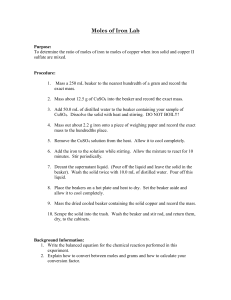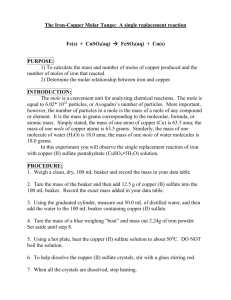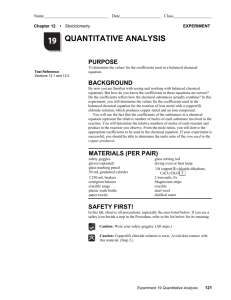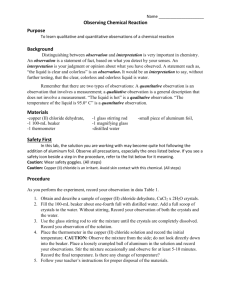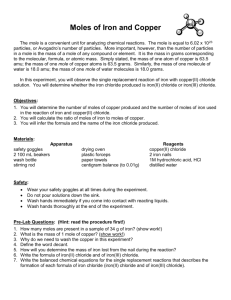Moles of Copper and Iron 4351
advertisement
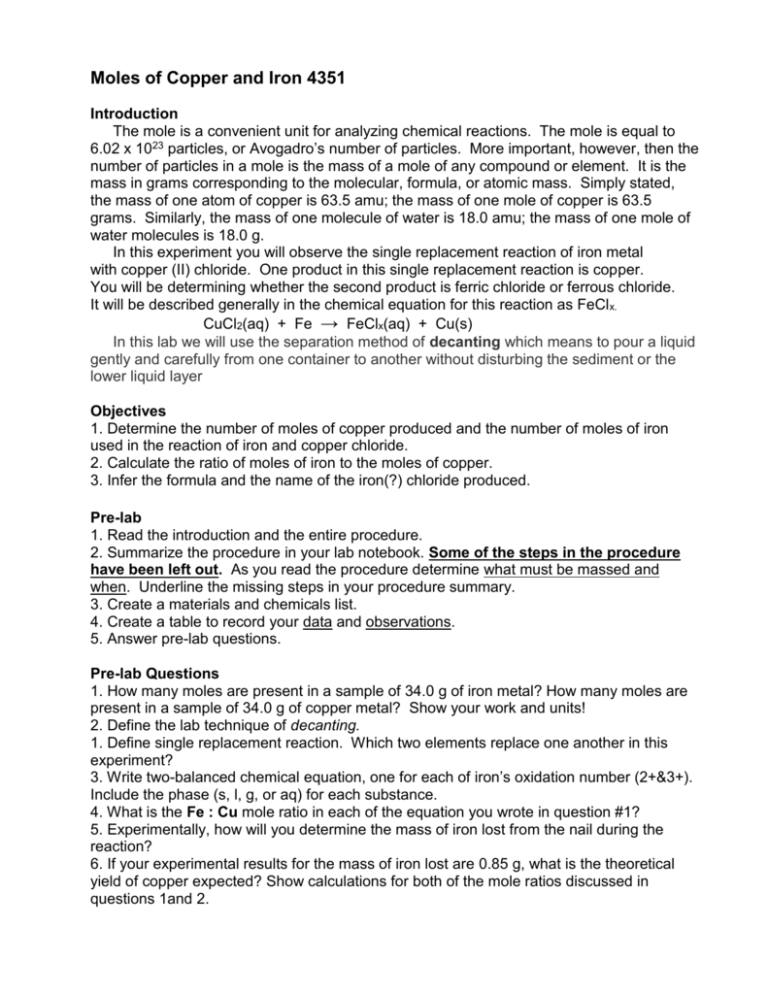
Moles of Copper and Iron 4351 Introduction The mole is a convenient unit for analyzing chemical reactions. The mole is equal to 6.02 x 1023 particles, or Avogadro’s number of particles. More important, however, then the number of particles in a mole is the mass of a mole of any compound or element. It is the mass in grams corresponding to the molecular, formula, or atomic mass. Simply stated, the mass of one atom of copper is 63.5 amu; the mass of one mole of copper is 63.5 grams. Similarly, the mass of one molecule of water is 18.0 amu; the mass of one mole of water molecules is 18.0 g. In this experiment you will observe the single replacement reaction of iron metal with copper (II) chloride. One product in this single replacement reaction is copper. You will be determining whether the second product is ferric chloride or ferrous chloride. It will be described generally in the chemical equation for this reaction as FeClx. CuCl2(aq) + Fe → FeClx(aq) + Cu(s) In this lab we will use the separation method of decanting which means to pour a liquid gently and carefully from one container to another without disturbing the sediment or the lower liquid layer Objectives 1. Determine the number of moles of copper produced and the number of moles of iron used in the reaction of iron and copper chloride. 2. Calculate the ratio of moles of iron to the moles of copper. 3. Infer the formula and the name of the iron(?) chloride produced. Pre-lab 1. Read the introduction and the entire procedure. 2. Summarize the procedure in your lab notebook. Some of the steps in the procedure have been left out. As you read the procedure determine what must be massed and when. Underline the missing steps in your procedure summary. 3. Create a materials and chemicals list. 4. Create a table to record your data and observations. 5. Answer pre-lab questions. Pre-lab Questions 1. How many moles are present in a sample of 34.0 g of iron metal? How many moles are present in a sample of 34.0 g of copper metal? Show your work and units! 2. Define the lab technique of decanting. 1. Define single replacement reaction. Which two elements replace one another in this experiment? 3. Write two-balanced chemical equation, one for each of iron’s oxidation number (2+&3+). Include the phase (s, l, g, or aq) for each substance. 4. What is the Fe : Cu mole ratio in each of the equation you wrote in question #1? 5. Experimentally, how will you determine the mass of iron lost from the nail during the reaction? 6. If your experimental results for the mass of iron lost are 0.85 g, what is the theoretical yield of copper expected? Show calculations for both of the mole ratios discussed in questions 1and 2. Procedure: Record all data in your table with pen! Write observations of all reactants and products in your data table! 1. Put on your safety goggles and laboratory apron. Take a 100 mL beaker and label it with your name, weight, and record the mass in your data table. 2. Put it on scale again and zero the scale. Add about 2.50 g cupric chloride, then add about 20 mL of distilled water and use a glass stirring rod to make sure that all of the cupric chloride crystals have dissolved. 3. Obtain two clean dry nails. 4. (Write the missing step) 5. Place nails in the cupric chloride solution. Leave the nails undisturbed for 30-40 min During that time, you should see the formation of copper in the beaker as some of the iron will react with the chlorine. 6. Use tweezers to carefully pick up the nails, one at a time. Use the wash bottle to rinse any remaining copper from the nails before removing them completely. If necessary, use the stirring rod or tweezers to scrape any copper of the nails. Be careful not to lose the solid copper! Set the nails aside to dry on a paper towel. (See picture below) 7. (Write the missing step) 8. Carefully decant the liquid from the solid. Pour the liquid into another beaker so that in case some of the solid is poured out, you can retrieve it. (See picture below) 9. After decanting, rinse the copper solid again with about 15 mL of distilled water. Decant again. Repeat this step 3 or 4 times. 10. Wash the copper solid with about 10 mL of 1M hydrochloric acid. Decant again. Finally, wash the solid one more time with 15 ml of distilled water and decant. 11. After the final washing and decanting, place the beaker with the copper in a drying oven. Be sure your beaker has some identification so that you can retrieve it the following day. 12. Before leaving the laboratory, clean up all materials and wash your hands thoroughly. 10. Next day: Retrieve your beaker and weigh it. Record the mass in your data table. Calculations- Show your work and units! Give a brief explanation for each! 1. Calculate the number of moles of Iron reacted. (Do NOT maintain sig figs.) 2. Calculate the number of moles of copper produced. (Do NOT maintain sig figs.) 3. Calculate the mole ratio of iron to copper. 4. Calculate the theoretical and % yield of copper 5. Calculate the % error in your experiment from the theoretical yield of copper and the experimental copper yield using the formula below: % error Theoretical Experimental x 100 Theoretical Analysis Questions 1. Observations: What happened to the nails? What was the color of the solution before and after the nails were put in? Explain the change in color of the solution. 2. Based on the results of your experiment, which form of iron(?) chloride was produced in this reaction? Explain. 3. Write the word equation summarizing the reaction. (Use # of moles (s) and (aq)) 4. Why did we wash the copper solid produced with acid? (Hint: all substances, except for the Cu metal, exist as ions in the solution. The excess chlorine ions will react with ….) 5. List three possible sources of error in this experiment, and describe how it would affect the Fe : Cu ratio. 6. Would a reverse reaction of the one observed in this lab will occur? (i.e. if copper metal was placed in a ferrous chloride solution) Explain. Write a Conclusion Paragraph

